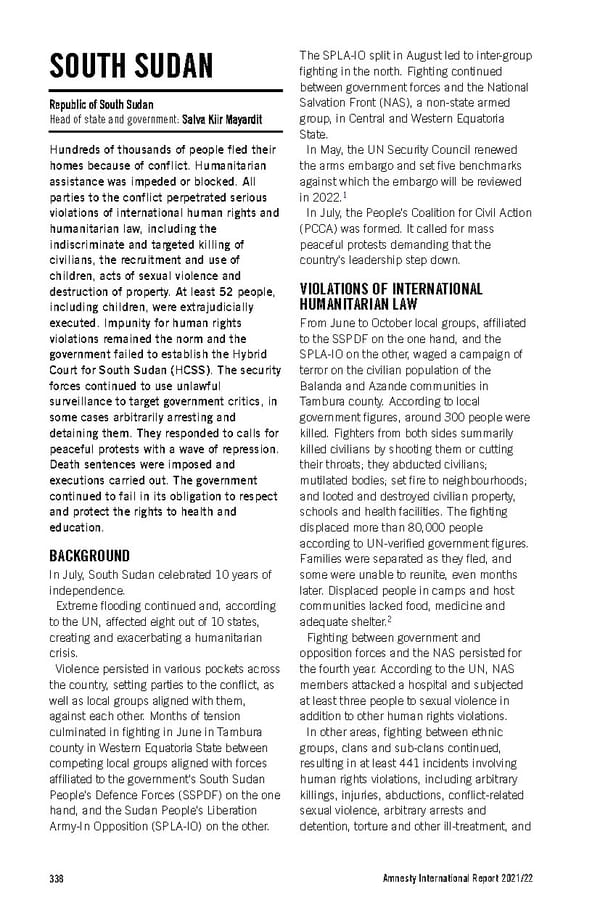The SPLA-IO split in August led to inter-group SOUTH SUDAN fighting in the north. Fighting continued between government forces and the National Republic of South Sudan Salvation Front (NAS), a non-state armed Head of state and government: Salva Kiir Mayardit group, in Central and Western Equatoria State. Hundreds of thousands of people fled their In May, the UN Security Council renewed homes because of conflict. Humanitarian the arms embargo and set five benchmarks assistance was impeded or blocked. All against which the embargo will be reviewed parties to the conflict perpetrated serious in 2022.1 violations of international human rights and In July, the People’s Coalition for Civil Action humanitarian law, including the (PCCA) was formed. It called for mass indiscriminate and targeted killing of peaceful protests demanding that the civilians, the recruitment and use of country’s leadership step down. children, acts of sexual violence and VIOLATIONS OF INTERNATIONAL destruction of property. At least 52 people, HUMANITARIAN LAW including children, were extrajudicially executed. Impunity for human rights From June to October local groups, affiliated violations remained the norm and the to the SSPDF on the one hand, and the government failed to establish the Hybrid SPLA-IO on the other, waged a campaign of Court for South Sudan (HCSS). The security terror on the civilian population of the forces continued to use unlawful Balanda and Azande communities in surveillance to target government critics, in Tambura county. According to local some cases arbitrarily arresting and government figures, around 300 people were detaining them. They responded to calls for killed. Fighters from both sides summarily peaceful protests with a wave of repression. killed civilians by shooting them or cutting Death sentences were imposed and their throats; they abducted civilians; executions carried out. The government mutilated bodies; set fire to neighbourhoods; continued to fail in its obligation to respect and looted and destroyed civilian property, and protect the rights to health and schools and health facilities. The fighting education. displaced more than 80,000 people BACKGROUND according to UN-verified government figures. Families were separated as they fled, and In July, South Sudan celebrated 10 years of some were unable to reunite, even months independence. later. Displaced people in camps and host Extreme flooding continued and, according communities lacked food, medicine and 2 to the UN, affected eight out of 10 states, adequate shelter. creating and exacerbating a humanitarian Fighting between government and crisis. opposition forces and the NAS persisted for Violence persisted in various pockets across the fourth year. According to the UN, NAS the country, setting parties to the conflict, as members attacked a hospital and subjected well as local groups aligned with them, at least three people to sexual violence in against each other. Months of tension addition to other human rights violations. culminated in fighting in June in Tambura In other areas, fighting between ethnic county in Western Equatoria State between groups, clans and sub-clans continued, competing local groups aligned with forces resulting in at least 441 incidents involving affiliated to the government’s South Sudan human rights violations, including arbitrary People’s Defence Forces (SSPDF) on the one killings, injuries, abductions, conflict-related hand, and the Sudan People’s Liberation sexual violence, arbitrary arrests and Army-In Opposition (SPLA-IO) on the other. detention, torture and other ill-treatment, and Amnesty International Report 2021/22 338
 Amnesty International Report 2021/22 Page 337 Page 339
Amnesty International Report 2021/22 Page 337 Page 339